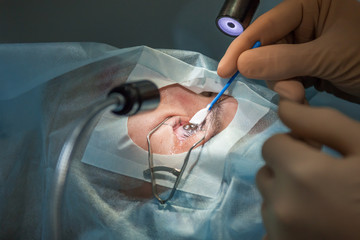What is LASIK?

LASIK is a surgical procedure used to rectify a particular set of vision problems called refractive errors with the help of advanced laser technology.
Refractive errors include conditions such as farsightedness, nearsightedness, astigmatism, and presbyopia (age-related farsightedness).
The procedure employs the use of lasers to reshape the cornea. The reshaping of the cornea helps adjust how the light hits the retina so that the optic nerve may process a better focused, and more precise picture.
LASIK was first introduced about two decades ago and is approved and monitored by the U.S. Food and Drug Administration (FDA). Technological advancements over the years have enabled faster LASIK surgeries, minimal post-op pain, and quicker recovery time.
Although LASIK is a minimally invasive procedure with a high success rate, it is still a surgical procedure, which means that it comes with its fair share of complications and side effects. People have to combat issues ranging from nerve damage to dry eyes.
Is LASIK Painful?
Post-op pain is a rare finding with LASIK. Ideally, it should not persist for more than a few hours and is easily manageable. If the pain does continue for any reason, it indicates the presence of other underlying issues that can be fixed with supplementary procedures.
If you are worried about pain, it is imperative that you understand the process step-by-step.
Before the procedure, you will be asked to stop wearing makeup and other scented products. This preventive measure helps reduce the likelihood of developing inflammation, irritation, or infection, and thus post-op pain.
Do not expect general anesthesia for the procedure. You will be completely conscious during the procedure. Your eyes will first be exposed to anesthetizing eye drops, so you won’t not experience pain. If medical procedures make you anxious, consult your doctor about prescription anti-anxiety medications to help you stay relaxed during the procedure. General anesthesia and sedation are only considered as the last resort in extreme cases.
The duration of the surgery is between 3 and 15 minutes per eye, depending on the type of LASIK procedure you choose to undergo, i.e., epi-LASIK, LASEK, or traditional LASIK.
After the procedure, protective bandage contact lenses will cover your eyes. You will be asked to wear an eye mask to reduce the risk of any damage to your eyes. You may also be advised to keep your eyes closed for the first few hours after the surgery and wear tinted glasses to reduce any strain on the eyes due to light.
Pain in the first few hours after surgery is normal. Mild burning due to dryness is also a common finding. In fact, some may even experience dryness for three to six months following surgery. Both these issues can be effectively managed with the help of eye drops and medication.
Pain after LASIK: What does it mean?
If you experience pain for more than one day after your surgery, you should be concerned. The cornea heals superficially within a few weeks. Complete healing, including reshaping of the cornea following regrowth and tissue adjustment, takes a few months, but the process is not painful.
If your pain does not go away, consult your doctor immediately because you may have an underlying complication due to the surgery.
Complications that may result in pain include:
- Dry eyes
- Light sensitivity
- Glares or halos
- Undercorrections, overcorrections, or astigmatism
- Flap healing problems
- Nerve damage to the retina and surrounding tissues
- Vision loss
- Inflammation
- Infection
Pain indicates potential long-term side effects. These side effects, however, can go away smoothly within six months.
According to a study published in the Molecular Pain journal, 20 to 55% of the people who undergo LASIK experience side effects.
Is there any way to reduce LASIK associated pain?
There is a variety of refractive surgeries based on LASIK that can help reduce pain as well as recovery time.
Epi-LASIK is one such procedure that has been proved to be very beneficial in reducing post-op pain. A research study published in the Journal of Refractive Surgery noted that Epi-LASIK patients reported significantly less post-op pain as compared to others.
Debunking myths about LASIK
There are various myths surrounding LASIK procedures, so let us just set the record straight once and for all.
-
LASIK is painful
No, LASIK is not painful. There is mild discomfort involved, but that typically only lasts a few hours after the surgery.
-
LASIK is painful because you are conscious during the procedure
Again, no, LASIK is not painful. Yes, you are awake during the procedure; however, your eyes are numbed prior to the procedure with anesthetic drops. There are no tools involved since lasers are used in the process.
-
LASIK can burn your eyes
The lasers used in LASIK are functionally non-thermal which means that they do not use heat but invisible light to treat the eye. So if you are planning to go for LASIK surgery, be assured the procedure is safe, as it doesn’t hurt your eyes.
- LASIK is more painful for people with astigmatism
Regardless of your underlying issue, the LASIK procedure is carried out in the same way. Therefore, you would feel the same amount of discomfort as anyone else. There are even benefits of LASIK surgery for people with astigmatism.
-
LASIK is less painful if the procedure costs more
Post-op pain and procedure costs are unrelated. The success or failure of your surgery depends on your doctor’s expertise and post-op care. Opt for an ophthalmologist that is qualified and skilled.
Parting thoughts
LASIK has benefitted millions across the globe. Consult your optometrist or ophthalmologist to find out if you are the right candidate for LASIK.








